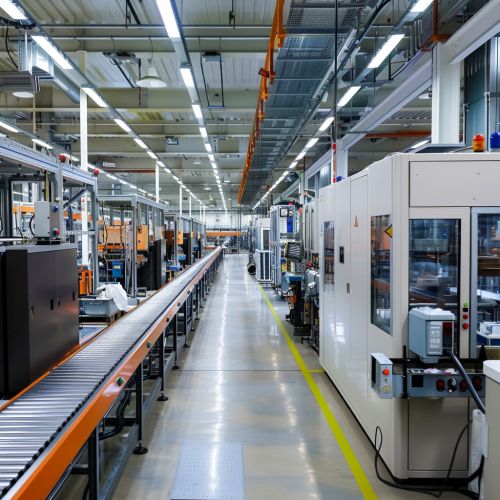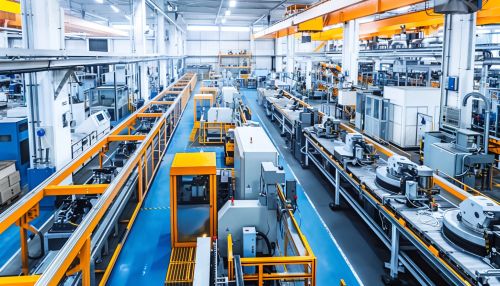The Factory
Introduction
A factory, also known as a manufacturing plant or production facility, is an industrial site where goods are produced on a large scale. Factories are a critical component of modern industrialized economies, serving as the backbone for the production of a wide range of products, from consumer goods to industrial equipment. The evolution of factories has been instrumental in shaping economic, social, and technological landscapes.
Historical Development
Early Factories
The concept of factories dates back to ancient times, with early examples found in the Roman and Chinese civilizations. These early factories were primarily workshops where artisans and craftsmen produced goods by hand. The Industrial Revolution in the 18th century marked a significant turning point, leading to the establishment of large-scale factories powered by steam engines and later by electricity.
The Industrial Revolution
The Industrial Revolution began in Britain in the late 18th century and spread to other parts of the world. It was characterized by the transition from manual labor to mechanized production. Key innovations such as the spinning jenny, the power loom, and the steam engine revolutionized textile manufacturing, leading to the establishment of textile mills and factories. This period also saw the rise of ironworks and steel mills, which played a crucial role in the development of infrastructure and machinery.
20th Century and Beyond
The 20th century witnessed further advancements in factory technology and management practices. The introduction of assembly lines by Henry Ford in the early 1900s revolutionized mass production, significantly increasing efficiency and reducing costs. The post-World War II era saw the rise of automation and computerization in factories, leading to the development of smart factories and Industry 4.0.
Types of Factories
Factories can be classified based on the type of products they manufacture, the production processes they employ, and the scale of their operations.
Manufacturing Factories
Manufacturing factories produce finished goods from raw materials or components. These factories can be further divided into several categories:
- **Textile Factories**: Produce fabrics, garments, and other textile products.
- **Automobile Factories**: Manufacture vehicles and automotive components.
- **Electronics Factories**: Produce electronic devices such as smartphones, computers, and home appliances.
- **Food Processing Factories**: Process raw food materials into packaged food products.
Processing Factories
Processing factories focus on transforming raw materials into intermediate products that are used in further manufacturing processes. Examples include:
- **Chemical Plants**: Produce chemicals and petrochemicals.
- **Refineries**: Process crude oil into refined petroleum products.
- **Steel Mills**: Convert iron ore into steel.
Assembly Factories
Assembly factories specialize in assembling components into finished products. These factories often rely on assembly line techniques to streamline production. Common examples include:
- **Automobile Assembly Plants**: Assemble various parts and components to produce vehicles.
- **Electronics Assembly Plants**: Assemble electronic components to produce devices such as computers and smartphones.
Factory Layout and Design
The layout and design of a factory are critical factors that influence its efficiency, productivity, and safety. Factory layout refers to the arrangement of machinery, equipment, and workstations within the facility.
Types of Factory Layouts
- **Process Layout**: Also known as functional layout, this type arranges machinery and equipment based on the process or function they perform. It is suitable for factories producing a wide variety of products in small quantities.
- **Product Layout**: Also known as line layout, this type arranges machinery and equipment in a linear sequence based on the production process. It is ideal for mass production of a single product or a few similar products.
- **Fixed-Position Layout**: In this layout, the product remains stationary, and workers, machinery, and equipment are brought to the product. It is commonly used for large, bulky products such as ships and airplanes.
- **Cellular Layout**: This layout groups machinery and equipment into cells based on similar production processes. It is designed to improve flexibility and efficiency in producing a variety of products.
Factors Influencing Factory Design
Several factors influence the design of a factory, including:
- **Product Type**: The nature of the product being manufactured determines the type of machinery and equipment required.
- **Production Volume**: The scale of production influences the layout and capacity of the factory.
- **Workflow Efficiency**: The design should minimize material handling and movement to enhance efficiency.
- **Safety and Compliance**: The factory design must adhere to safety regulations and standards to ensure a safe working environment.
- **Flexibility**: The design should allow for future expansion and modifications to accommodate changes in production requirements.


Factory Management and Operations
Effective factory management is essential for optimizing production processes, ensuring quality, and maintaining a safe working environment. Factory management encompasses various aspects, including production planning, quality control, maintenance, and workforce management.
Production Planning
Production planning involves scheduling and coordinating production activities to meet demand while optimizing resources. Key components of production planning include:
- **Demand Forecasting**: Predicting future demand for products to plan production schedules.
- **Capacity Planning**: Determining the production capacity required to meet demand.
- **Inventory Management**: Managing raw materials, work-in-progress, and finished goods inventory to ensure a smooth production flow.
- **Scheduling**: Allocating resources and setting timelines for production activities.
Quality Control
Quality control ensures that products meet specified standards and customer requirements. It involves:
- **Inspection and Testing**: Conducting inspections and tests at various stages of production to identify defects and ensure quality.
- **Process Control**: Monitoring and controlling production processes to maintain consistency and quality.
- **Continuous Improvement**: Implementing practices such as Total Quality Management (TQM) and Six Sigma to continuously improve quality and reduce defects.
Maintenance
Regular maintenance of machinery and equipment is crucial for preventing breakdowns and ensuring smooth operations. Maintenance activities include:
- **Preventive Maintenance**: Scheduled maintenance to prevent equipment failures and extend the lifespan of machinery.
- **Predictive Maintenance**: Using data and analytics to predict and address potential issues before they lead to equipment failure.
- **Corrective Maintenance**: Repairing or replacing faulty equipment to restore normal operations.
Workforce Management
Effective workforce management is essential for maintaining productivity and ensuring a safe working environment. Key aspects of workforce management include:
- **Training and Development**: Providing training and development opportunities to enhance the skills and knowledge of workers.
- **Health and Safety**: Implementing safety protocols and measures to protect workers from hazards and ensure compliance with regulations.
- **Labor Relations**: Managing relationships with workers and labor unions to address grievances and maintain a positive work environment.
Technological Advancements in Factories
Technological advancements have significantly transformed factories, leading to increased efficiency, productivity, and flexibility. Key technological innovations include:
Automation and Robotics
Automation involves using machinery and equipment to perform tasks with minimal human intervention. Robotics, a subset of automation, involves using robots to perform repetitive and complex tasks. Benefits of automation and robotics include:
- **Increased Efficiency**: Automation reduces the time and effort required for production processes.
- **Improved Quality**: Robots can perform tasks with high precision and consistency, reducing defects.
- **Cost Savings**: Automation reduces labor costs and increases productivity.
Computer-Aided Design (CAD) and Computer-Aided Manufacturing (CAM)
CAD and CAM technologies have revolutionized product design and manufacturing. CAD involves using computer software to create detailed designs and models of products. CAM involves using computer software to control machinery and equipment for manufacturing products. Benefits of CAD and CAM include:
- **Enhanced Design Accuracy**: CAD allows for precise and detailed product designs.
- **Streamlined Production**: CAM automates manufacturing processes, reducing production time and costs.
- **Flexibility**: CAD and CAM enable quick modifications to designs and production processes.
Internet of Things (IoT)
The IoT involves connecting machinery, equipment, and devices to the internet to collect and exchange data. In factories, IoT enables:
- **Real-Time Monitoring**: IoT devices can monitor production processes and equipment in real-time, providing valuable data for decision-making.
- **Predictive Maintenance**: IoT sensors can detect potential issues and trigger maintenance activities before equipment failure occurs.
- **Improved Efficiency**: IoT data can be used to optimize production processes and reduce downtime.
Artificial Intelligence (AI) and Machine Learning
AI and machine learning technologies are increasingly being integrated into factory operations. Applications of AI and machine learning in factories include:
- **Predictive Analytics**: AI algorithms can analyze data to predict demand, optimize inventory, and improve production planning.
- **Quality Control**: Machine learning algorithms can analyze data from inspections and tests to identify defects and improve quality control processes.
- **Process Optimization**: AI can optimize production processes by analyzing data and identifying areas for improvement.
Environmental Impact of Factories
Factories have a significant impact on the environment, contributing to pollution, resource depletion, and climate change. Addressing the environmental impact of factories is crucial for sustainable development.
Pollution
Factories are a major source of air, water, and soil pollution. Common pollutants include:
- **Air Pollution**: Emissions from factories, such as carbon dioxide, sulfur dioxide, and particulate matter, contribute to air pollution and global warming.
- **Water Pollution**: Discharge of industrial waste and chemicals into water bodies leads to water pollution, affecting aquatic life and human health.
- **Soil Pollution**: Improper disposal of industrial waste and chemicals can contaminate soil, affecting agriculture and ecosystems.
Resource Depletion
Factories consume significant amounts of natural resources, including water, energy, and raw materials. Resource depletion can lead to:
- **Water Scarcity**: Excessive water consumption by factories can lead to water scarcity, affecting communities and ecosystems.
- **Energy Consumption**: Factories are major consumers of energy, contributing to the depletion of fossil fuels and increasing greenhouse gas emissions.
- **Raw Material Depletion**: Over-extraction of raw materials can lead to resource depletion and environmental degradation.
Climate Change
Factories contribute to climate change through greenhouse gas emissions. Key contributors include:
- **Carbon Emissions**: Burning fossil fuels for energy in factories releases carbon dioxide, a major greenhouse gas.
- **Methane Emissions**: Certain industrial processes, such as chemical manufacturing, release methane, a potent greenhouse gas.
- **Deforestation**: Clearing land for factory construction and raw material extraction contributes to deforestation and loss of carbon sinks.
Sustainable Practices in Factories
Adopting sustainable practices in factories is essential for reducing their environmental impact and promoting sustainability.
Energy Efficiency
Improving energy efficiency in factories can reduce energy consumption and greenhouse gas emissions. Strategies include:
- **Energy-Efficient Machinery**: Using energy-efficient machinery and equipment to reduce energy consumption.
- **Renewable Energy**: Integrating renewable energy sources, such as solar and wind power, into factory operations.
- **Energy Management Systems**: Implementing energy management systems to monitor and optimize energy use.
Waste Management
Effective waste management practices can minimize the environmental impact of factory waste. Strategies include:
- **Reduce, Reuse, Recycle**: Implementing practices to reduce waste generation, reuse materials, and recycle waste.
- **Waste Treatment**: Treating industrial waste before disposal to minimize pollution.
- **Circular Economy**: Adopting circular economy principles to design products and processes that minimize waste and promote resource efficiency.
Water Conservation
Water conservation practices can reduce water consumption and minimize the impact on water resources. Strategies include:
- **Water-Efficient Processes**: Implementing water-efficient production processes to reduce water consumption.
- **Water Recycling**: Recycling and reusing water within factory operations.
- **Rainwater Harvesting**: Collecting and using rainwater for non-potable purposes.
Sustainable Supply Chain
Promoting sustainability throughout the supply chain can enhance the overall sustainability of factory operations. Strategies include:
- **Sustainable Sourcing**: Sourcing raw materials from sustainable and ethical suppliers.
- **Supply Chain Transparency**: Ensuring transparency and traceability in the supply chain to promote sustainability.
- **Collaboration**: Collaborating with suppliers and partners to implement sustainable practices.
Conclusion
Factories play a vital role in modern economies, driving industrialization and economic growth. However, their environmental impact and resource consumption pose significant challenges. Adopting sustainable practices and leveraging technological advancements can enhance the efficiency, productivity, and sustainability of factories, contributing to a more sustainable future.
